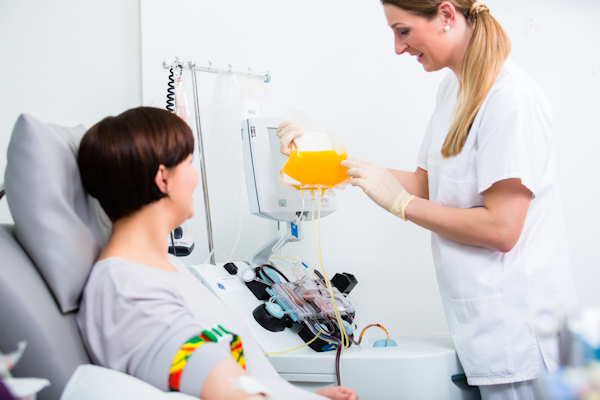Patients who recover from COVID-19 often feel fortunate, motivated to help others stricken with the disease.
One opportunity, employed in previous pandemics and under study with COVID-19, is the infusion of blood plasma – rich in antibodies from survivors – for those critically ill with the disease.
Tanner Health System is one of almost 2,200 health care systems across the country joining the Mayo Clinic Expanded Access Program to test the efficacy of convalescent plasma – plasma from someone who has overcome COVID-19 – to help other sick patients survive the disease or recover faster. The trial is more than halfway toward its goal of testing the treatment with 10,000 patients. If you have fully recovered from the virus, you may also donate.
“Liquid gold” can save lives. Blood plasma is sometimes referred to as “liquid gold” due to its potentially lifesaving contents and the rich color of the plasma once it’s separated from red blood cells during the donation process.
The COVID-19-specific evidence for convalescent plasma is anecdotal to-date, but experts are optimistic.
Convalescent plasma is considered an experimental treatment to treat this new infection, according to Bonnie Boles, MD, the vice president of clinical transformation overseeing the convalescent plasma donation project for Tanner.
“We have no vaccine or clear-cut treatment for COVID-19 yet, and people are still getting sick,” said Dr. Boles. “Everyone wants to know what they can do to help, and convalescent plasma is potentially life-saving. Its track record with other viruses is well-established, including ebola in 2019, H1N1 influenza in 2009, avian flu in 2003, SARS in 2002 and even the Spanish Flu back in 1918.”
 It’s very encouraging for patients and their families that it could help sick patients improve or prevent them from getting sicker. And, if it is proven effective, we will be better prepared for the anticipated second wave of COVID-19 before a vaccine likely can be developed and approved for wide scale use,” said Dr. Boles.
It’s very encouraging for patients and their families that it could help sick patients improve or prevent them from getting sicker. And, if it is proven effective, we will be better prepared for the anticipated second wave of COVID-19 before a vaccine likely can be developed and approved for wide scale use,” said Dr. Boles.
Identifying eligible plasma donors
The American Red Cross is coordinating the donor identification process, including testing to confirm the presence of antibodies. Tanner has reached out to some of its COVID-19 patients by phone to make them aware of the opportunity to donate.
The requirements for donors include:
- At least 17 years old and weigh 110 pounds. Additional weight requirements apply for donors 18 or younger;
- In good health. You generally feel well, even if you're being treated for a chronic condition; and
- Have a prior, verified diagnosis of COVID-19, but are now symptom free and fully recovered from COVID-19.
Patients meeting all the criteria above and willing to help should:
- Complete the “Donor Request” form by visiting the Red Cross website at https://www.redcrossblood.org/;
- Select “Donate Blood.” The drop down to the far right is the link to “Covid-19 Convalescent Plasma Donation”
If you do not have access to a computer or smartphone, call the Red Cross at 1-800-733-2767.
Donating convalescent plasma is like donating blood – but donors get their red blood cells back!
Once approved, the donation of blood plasma is similar to donating whole blood and takes about the same amount of time – roughly an hour. The antibody-rich plasma is separated from the red blood cells, which are returned to the donor’s body. The donor’s body quickly replaces the extracted plasma; another donation is possible in about a week to 10 days. For typical whole-blood donations, a three-month waiting period is required in between donations.
According to Dr. Boles, the typical donation is 700 milliliters of plasma. The typical infusion for a sick patient is 200 milliliters, so the donation can be used to help up to three patients.
Receiving convalescent plasma
With the Mayo Clinic trial guidelines and still-developing pipeline for plasma donations, only the sickest patients are currently eligible to receive plasma donations.
According to Dr. Boles, patients eligible to receive the plasma must be critically ill with respiratory failure, on a ventilator or likely to go on a ventilatory, and likely to develop other organ failure. Blood type must also be matched, as with whole blood transfusions. Due to the critical state of eligible patients, there is a race against time to get the donations to patients.
Dr. Boles encourages those who have recovered from COVID-19 to consider donating their plasma to this nationwide study.
“You can not only support our community’s participation in this study to determine convalescent plasma’s effectiveness, but you may save lives and answer questions about this potential treatment for many,” she said.
More about Tanner’s COVID-19 response can be found at tanner.org/ncov.